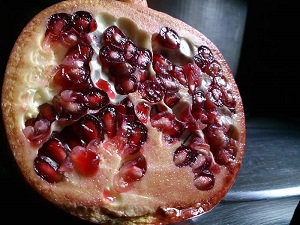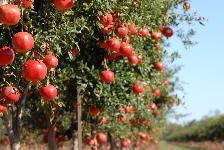Growing a Pomegranate Tree
By: Joy Derksen, Master Gardener Volunteer 2004
Come the holidays and I think of the pomegranate tree. Dressed up for the holidays with a quantity of ornament-like fruits hanging on the edges of the branches, it’s integral to seasonal décor. If you are looking for a small ornamental fruit tree for your home, the pomegranate (Punica granatum L.) could be a good choice.
Description
Brought to the Americas by the Spanish missionaries in the 1500’s, this fruit tree has been grown commercially in both California and Florida. While the tree prefers soil in the pH range 5.5 to 7.0 to produce heavily, it can also live in more alkaline, sandy soil. Our climate agrees with the pomegranate, as it tolerates both our hot summers and thrives in moderately cold weather (above 10 degrees). In colder areas the tree loses its leaves in winter. Closer to the coast the leaves sometimes remain through the cool season. Although the pomegranate is naturally a dense shrub, it is often trained as a single trunk, small tree.
Plant a pomegranate tree from late February to March. Florida’s Arbor Day 2020 is Friday, January 17th. Consider planning planting a pomegranate tree!
Care and Maintenance
In spring and su mmer, bright orange-red flowers show well against the dark green foliage. The resulting fruit ripens from July to November. Depending on the cultivar, the fruit can be golden to deep red in color. The trees are self-pollinating, so a single tree is all that is necessary.
mmer, bright orange-red flowers show well against the dark green foliage. The resulting fruit ripens from July to November. Depending on the cultivar, the fruit can be golden to deep red in color. The trees are self-pollinating, so a single tree is all that is necessary.
The pomegranate tree likes dry weather, but should be watered once every 7 to 10 days if we don’t have rain. It will survive some flooding. Much like citrus, too much or too little water can result in the fruit splitting.
The trees need to be fertilized twice a year—once in November and again in March. (This makes the pomegranate a good choice for part time residents!). Use 8-8-8 fertilizer sparingly. Young trees get 2-2.5 lbs. each time. Mature trees get 4.5 -6.5 lbs. Too much fertilizer delays fruit maturity and reduces the color and quantity of the fruit. Light pruning and removal of dead or damaged wood can be done during the late winter months to encourage production of good quality fruit.
The tree is relatively pest free. Fungus-causing leaf blotch can be controlled with copper fungicide. Scale insects can be controlled by an application of oil spray during the winter when leaves are not present.
More Information
For even more information on cultivars, pruning and general care read “The Pomegranate” publication: http://edis.ifas.ufl.edu/mg056 or call the Manatee County Master Gardener Volunteers at 941-722-4524.
 0
0

